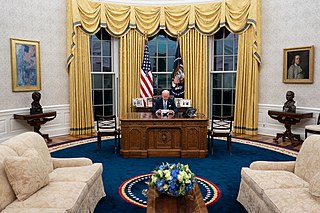
The Oval Office is the formal working space of the president of the United States. Part of the Executive Office of the President of the United States, it is in the West Wing of the White House, in Washington, D.C.
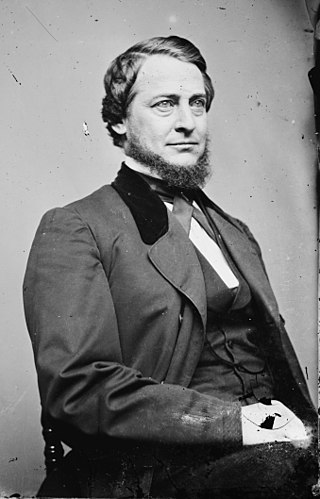
Clement Laird Vallandigham was an American lawyer and politician who served as the leader of the Copperhead faction of anti-war Democrats during the American Civil War.
City Point was a town in Prince George County, Virginia, United States, that was annexed by the independent city of Hopewell in 1923. It served as headquarters of the Union Army during the siege of Petersburg during the American Civil War.

George Peter Alexander Healy was an American portrait painter. He was one of the most prolific and popular painters of his day, and his sitters included many of the eminent personages of his time. Born in Boston, he studied in Europe, and over his lifetime had studios in Paris and Chicago.

David Dixon Porter was a United States Navy admiral and a member of one of the most distinguished families in the history of the U.S. Navy. Promoted as the second U.S. Navy officer ever to attain the rank of admiral, after his adoptive brother David G. Farragut, Porter helped improve the Navy as the Superintendent of the U.S. Naval Academy after significant service in the American Civil War.
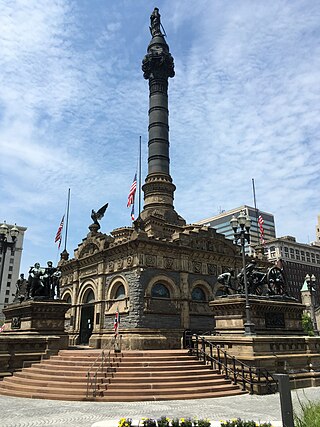
The Cuyahoga County Soldiers' and Sailors' Monument is a major Civil War monument in Cleveland, Ohio, honoring the more than 9,000 individuals from Cuyahoga County who served the Union throughout the war. It was dedicated on July 4, 1894, and is located on the southeast quadrant of Public Square in Downtown Cleveland. It was designed by architect and Civil War veteran Levi Scofield, who also created the monument's sculptures. The monument is regularly open to the public, free of charge.

The Lincoln Bedroom is a bedroom which is part of a guest suite in the southeast corner of the second floor of the White House in Washington, D.C. The Lincoln Sitting Room makes up the other part of the suite. The room is named for President Abraham Lincoln, who used the room as an office.
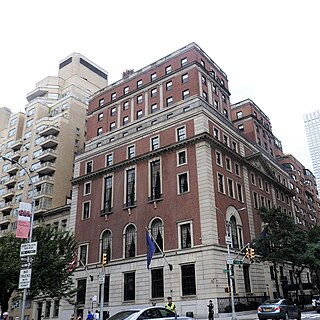
The Union League Club is a private social club in New York City that was founded in 1863 in affiliation with the Union League. Its fourth and current clubhouse is located at 38 East 37th Street on the corner of Park Avenue, in the Murray Hill neighborhood of Manhattan. It was designed by Benjamin Wistar Morris and opened on February 2, 1931. The building was designated a New York City landmark on October 25, 2011. The club is considered one of the most prestigious in New York City.

Francis Bicknell Carpenter was an American painter born in Homer, New York. Carpenter is best known for his painting First Reading of the Emancipation Proclamation of President Lincoln, which is hanging in the United States Capitol. Carpenter resided with President Lincoln at the White House and in 1866 published his one-volume memoir Six Months at the White House with Abraham Lincoln. Carpenter was a descendant of the New England Rehoboth Carpenter family.

The Treaty Room is located on the second floor of the White House, the official residence of the president of the United States. The room is a part of the first family's private apartments and is used as a study by the president.

Henry Ulke was an American photographer and portrait painter.
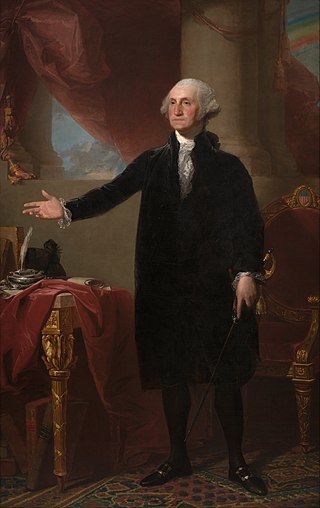
Beginning with painter Gilbert Stuart's portrait of George Washington, it has been tradition for the president of the United States to have an official portrait taken during their time in office, most commonly an oil painting. This tradition has continued to modern times, although since the adoption of photography as a widely used and reliable technology, the official portrait may also be a photograph.
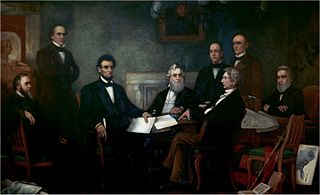
First Reading of the Emancipation Proclamation of President Lincoln is an 1864 oil-on-canvas painting by Francis Bicknell Carpenter. In the painting, Carpenter depicts Abraham Lincoln, the 16th president of the United States, and his Cabinet members reading over the Emancipation Proclamation, which proclaimed the freedom of slaves in the ten states in rebellion against the Union in the American Civil War on January 1, 1863. Lincoln presented the preliminary Emancipation Proclamation to his Cabinet on July 22, 1862 and issued it on September 22, 1862. The final Emancipation Proclamation took effect on January 1, 1863.

Abraham Lincoln is an 1869 oil-on-canvas painting by George Peter Alexander Healy of Abraham Lincoln, the 16th president of the United States.
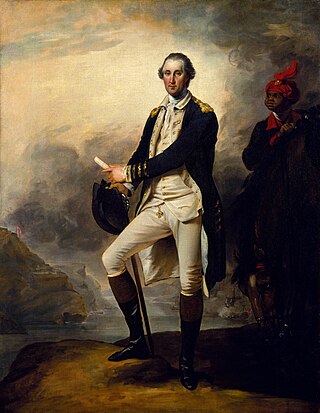
George Washington, also entitled George Washington and William Lee, is a full-length portrait in oil painted in 1780 by the American artist John Trumbull during the American Revolutionary War. General George Washington stands near his enslaved servant William Lee, overlooking the Hudson River in New York, with West Point and ships in the background. Trumbull, who once served as an aide-de-camp to Washington, painted the picture from memory while studying under Benjamin West in London. He finished it before his arrest for high treason in November. The portrait, measuring 36 in × 28 in, is on view in Gallery 753 at the Metropolitan Museum of Art in New York City. Originally in the possession of the de Neufville family of the Netherlands, it was bequeathed to the museum by Charles Allen Munn in 1924.
The following outline is provided as an overview of and topical guide to Abraham Lincoln:

Friedrich Julius Georg Dury (1817–1894) was a well-regarded Bavarian-American portrait artist who worked in both oil and pastel. He was born and educated in Würzburg, Bavaria, and Munich, where he began his career as an artist.
Portraits of the former President of the United States George W. Bush and First Lady Laura Bush were painted by the American portrait artist John Howard Sanden in 2011 and 2012 respectively. The paintings were unveiled in 2012 in a ceremony at the White House where they presently hang.

The Lincoln-Berry General Store was a general store that was co-owned by Abraham Lincoln. The store is one of the reconstructed 1830s buildings at Lincoln's New Salem, a state historic site. It was and is the only frame building in New Salem.


















